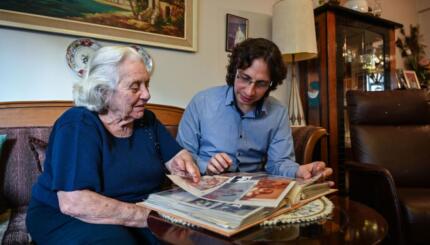Reprinted with permission from Modern Hebrew Literature, published by Behrman House.
The fundamental problem of language was for a long time overwhelming: an ancient or medieval Hebrew had to be adapted to modern literary needs, made to reflect the inner and outer world of people who did not even use it as a spoken tongue. It was not only a matter of developing a new lexicon for modern things–having Hebrew words for “locomotive” and “factory” and “pharmacy”–but a new lexicon for feelings and motives, even in certain respects a new syntax to express newly assimilated patterns of conceptualizing.
Finally, Haskalah (Enlightenment) literature was often seriously limited by its ideological character. Imaginative literature with a point to prove–or an axe to grind–often ends up being shaped by a narrow, shrilly insistent imagination, more concerned with laying down a program than evoking a complex world. As the Israeli critic Dov Sadan put it, the Haskalah writer, indignant over the ultra‑Orthodox Jew who wore a filthy kaftan instead of decent modern European dress, was in no position to describe that Jew in loving detail, as a novelist should, down to the last spot of grease on the kaftan.
A touching but artistically crippling quality of earnest naiveté persists in Haskalah fiction to the last: All would end well if only Jews would learn European languages, acquire decently productive professions, observe the laws of decorum and hygiene, in short, follow the path of the good goy who is the positive hero of a good many Haskalah stories.
With your help, My Jewish Learning can provide endless opportunities for learning, connection and discovery.
 In the 1880s, this whole situation began to change fundamentally. After a century of literary activity, Hebrew writers had at least made a start in developing their own viable traditions, and in learning how to assimilate their European literary models. More important, the old militancy toward the immediate Jewish past relaxed considerably, so that it was easier for a Hebrew writer to do work that was not so insistently ideological. Now it became possible to balance programmatic criticism with intimate insight and affection in rendering the world of Eastern European Jewry, and no one illustrates the artistic advantages of this new inner freedom more strikingly than Mendele Mokher Seforim (Shalom Yakov Abramowitz). Perhaps most important, however, is the sudden forward leap of individual genius, which could not have been predicted and cannot be accounted for merely in terms of broad historical causes. It seems almost as though Mendele waved a magic wand and made modern Hebrew prose possible.
In the 1880s, this whole situation began to change fundamentally. After a century of literary activity, Hebrew writers had at least made a start in developing their own viable traditions, and in learning how to assimilate their European literary models. More important, the old militancy toward the immediate Jewish past relaxed considerably, so that it was easier for a Hebrew writer to do work that was not so insistently ideological. Now it became possible to balance programmatic criticism with intimate insight and affection in rendering the world of Eastern European Jewry, and no one illustrates the artistic advantages of this new inner freedom more strikingly than Mendele Mokher Seforim (Shalom Yakov Abramowitz). Perhaps most important, however, is the sudden forward leap of individual genius, which could not have been predicted and cannot be accounted for merely in terms of broad historical causes. It seems almost as though Mendele waved a magic wand and made modern Hebrew prose possible.
Prose style had been one of the most problematic technical features of Haskalah writing. Though in fact there are many available styles to choose from in the three millennia of development which the Hebrew language has undergone, one may speak, broadly, of two basic kinds of Hebrew: biblical Hebrew, which has a relatively small, indigenously Semitic lexicon and is mainly paratactic in syntax (i.e., clauses are often juxtaposed without conjunctions); and rabbinic Hebrew, which reflects an enormous lexical influx from Greek, Latin, even Persian, and which is basically hypotactic (i.e., it uses coordinating or subordinating conjunctions to link clauses), with its own distinctive modifications of classical Hebrew grammar and morphology.
Philosophical and scholarly prose of the Haskalah did often adopt an uneven mélange of rabbinical Hebrew and later prose models. For prose fiction, on the other hand, the biblical style, with very few exceptions, was felt to be obligatory, as it was in poetry, because the language of the Bible seemed loftier, more decorous, had more cultural prestige, than those forms of Hebrew which were associated with rabbinic discourse and the pre‑modern, sequestered existence of the Diaspora. Biblical Hebrew, however, was a terribly cumbersome and inadequate medium for fiction, lacking the requisite resources of vocabulary, tightly restricted by the structures of its syntax in the organization of ideas, in the presentation of data about character and situation.
As late as the last generation of the Haskalah, in the Hebrew fiction of the 1860s, the characters hobble around on shaky stilts nailed together from the scraps and splinters of biblical verses, the language in which their world and their speech are conveyed. In Mendele’s work of the 1880s and 1890s, the characters suddenly are made to move and talk with the lifelike fluidity of real people. Fusing the Hebrew of the Bible, the Mishnah, the Midrash, the rabbinic commentaries, and a wealth of other sources, Mendele is able to give us, for example, a man descending from a sleigh, entering a house, peeling off layers of winter clothing, then lighting his pipe, with all the convincing vividness of a Dickens, a Gogol, a Balzac.
Bialik’s poetry, in an analogous way, suddenly illuminates layer after layer of past association in the Hebrew words it uses, all brought to bear on the expressive needs of the present, even as the language remains predominantly biblical, in sharp contrast to Haskalah poetry, which was so often a lifeless mosaic of biblical phrases. In a less spectacular way, the disciplined clarity of language in Ahad Ha‑am’s essays helps establish a new kind of expository prose, adapting Hebrew to modern requirements of analytic generalization.
While these decisive advances in style were being made, new qualities of innerness, emotional subtlety, introspective self‑confrontation began to manifest themselves in both poetry and prose. Hebrew became more a medium of intensely personal expression at the same time that it was often used, now in a non-ideological, unprogrammatic way, to probe the bewildering predicament of tradition‑bound Jewry thrust into a modern world where it could not feel at home. Thus the didactic concerns of the Haskalah became existential concerns, these writers only being more acutely aware than writers in firmly established national groups of the collective contexts for individual existence. The new complexity of consciousness among Hebrew writers also gradually led to experiments with literary form. Hebrew poetry would remain formally traditionalist until the 1920s, but by the first decade of the 20th century, one Hebrew writer in Russia, Uri Nissan Gnessin, was already experimenting with a mode of interior monologue, and in Palestine the Galician‑born Shmuel Yosef Agnon, at the beginning of his long career, was already reaching toward new possibilities of symbolism, expressionist fantasy, and structuring through motif.
For Hebrew writers in Russia, the most interesting recent achievements of Russian literature now began to be imaginatively assimilable; the same was true of recent German literature for writers in the Austro‑Hungarian cultural sphere.
© Behrman House Inc.


